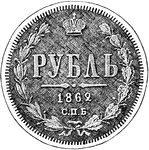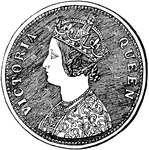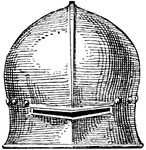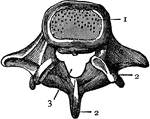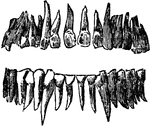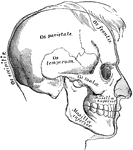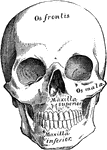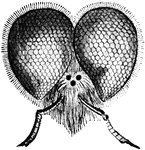
Pump
"The common pump consists of a hollow tube, the lower part of which, descending into the water, is called…

Forcing-Pump
"In the forcing-pump atmospheric pressure plays but a small part. There is no valve in the piston c,…

Chain-Pump
"The chain-pump consists of a tube or cylinder, the lower part of which is immersed in a well or reservoir,…
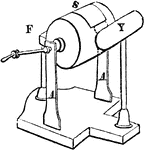
Electrical Machine
"A form of an electrical machine. S being the glass cylinder turning on an axis, Y the conductor, F…

Magnetic Telegraph
"Morse magnetic telegraph will be understood by reference to the accompanying diagram, which represents…
Egyptian Charm
"A small porcelain cylinder ornamented with interlaced lotus flowers in intaglio, having a ring for…

Lace Machine
"A section of part of a lace machine. E is the cylinder or beam upon which the lace is rolled as made,…
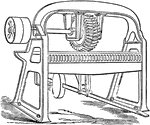
Striking Machine
"Striking machines are now very generally used for the operation. These consist of a drum or cylinder…

Catadioptric Holophote
"Catadioptric Holophote.—Part of the anterior hemisphere of rays is intercepted and at once parallelized…
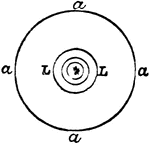
Catadioptric Holophote
"Catadioptric Holophote.—Part of the anterior hemisphere of rays is intercepted and at once parallelized…

Swans Designs
"Professor Swan's Designs.—Among several ingenious arrangements and new forms of agents proposed by…
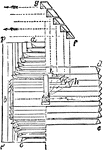
Condensing Octant
"Condensing Octant.—The central fixed apparatus bb with spherical mirror dd throws its rays directly…
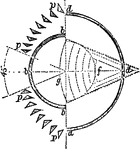
Condensing Octant
"Condensing Octant.—The central fixed apparatus bb with spherical mirror dd throws its rays directly…
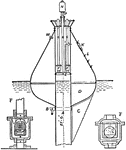
Automatic Buoy
"Courtney's Automatic Buoy. A, cylinder, 27 ft. 6 in. long; B, mooring shackle; C, rudder; D, buoy;…

Floating Lights
"aa is the mast, b tackle hook, c, c brass flanges for fixing parts of lantern together, e and g weather…

Rose Ryal
The front of a Rose Royal coin. It is a very rare English gold coin in the righ of King James 1. Worth…
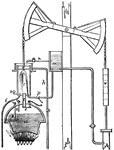
Newcomens Engine
"The simple outline of the atmospheric engine. Its mode of operation is as follows. Steam is admitted…

Double-acting Cylinder
"The first alteration to be noticed in the double-acting engine is that of the cylinder. To insure its…

Double-acting Cylinder
"The first alteration to be noticed in the double-acting engine is that of the cylinder. To insure its…
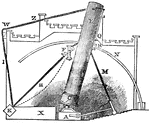
Telescope
"The following description of a section of Lord Rosse's telescope, though not so perfect as could be…

Skeletal Trunk
"The skeleton of the trunk and the limb arches seen from the front. C, clavicle; S, scapula; Oc, innominate…

Elbow-Joint
"The superficial veins in front of the elbow-joint. B', tendon of biceps muscle; Bi, brachialis internus…

Screw-Cutting
"A self-acting screw-cutting lathe with double-geared headstock, of a type now well established, the…
Femur
Section of the femur. 1: External view; 2: Cellular portion at end; 3: Hollow in middle; 4: Thick shell…

Bone Section
Longitudinal section of bone, a microscopic view. 1: Cells; 2: Canals; 3: Intercellular substance.

Bone Section
Cross-section of bone, a microscopic view. 1: Cells; 2: Canals; 3: Intercellular substance.
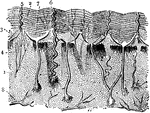
Skin
Vertical section of the skin, a microsopic view. 1: Cutis; 2: Cuticle in layers; 3: Papilla; 4: Nerves…

Oxy-calcium Lamp
"A small cylinder of lime is heated to intense luminosity in the flame of a spirit lamp through which…
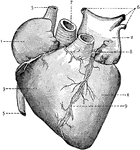
Heart
External view of the Heart. 1: Right Auricle; 2: Left Auricle; 3: Right Ventricle; 4: Left Ventricle;…
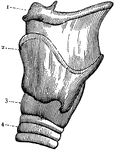
Larynx
External view of the left side of Larynx. 1: Front portion of hyoid bone; 2: Upper edge of larynx; 3:…
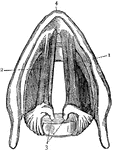
Larynx
Cross section of the larynx above the vocal cords. 1: Right vocal cord. 2: Left vocal cord. 3: Cartilages…
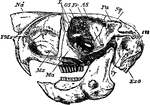
Cape Jumping Hare
"Side view of skull of Cape Jumping Hare. Pmx, premaxilla; Mx, maxilla; Ma, malar; Fr, frontal; L, lachrymal;…
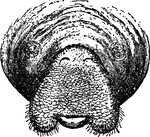
Manatee Face
"Front view of head of American Manatee, showing the eyes, nostrils, and mouth with the lobes of the…
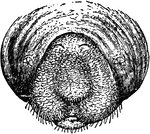
Manatee Face
"Front view of head of American Manatee, showing the eyes, nostrils, and mouth with the lip contracted."…
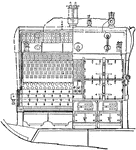
Babcock and Wilcox Water-tube Boiler
Babcock and Wilcox Water-tube Boiler, section at AB-front elevation

Regnaults Manometer
"AB is a strong metal tube, closed at the lower end, and carrying at the upper a bent pipe for admitting…
Compressed Air Manometer
"The compressed air manometer consists of a strong graduated glass tube of uniform narrow bore, closed…
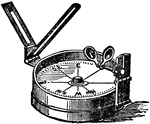
Azimuth Compass
"At sea the declination is generally observed by means of an azimuth compass invented by Kater. It consists…

Micrometer
"The original Merz micrometer of the Cape Observatory, made on Fraunhofer's model. S is the head of…
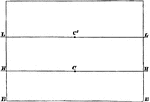
Horizontal Line Diagram
In this figure BB is the base line; HH the common horizontal or vanishing line; C…
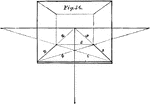
Parallel Perspective
The perspective shown in this plate is parallel perspective; and the subject here intended to be represented…

Angular Perspective
The perspective in this plate is "angular perspective," and the figure it represents is a flat square…
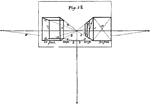
Parallel Perspective
Two upright oblong figures are here represented in parallel perspective. They may be imagined to resemble…
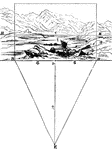
Distance
"A landscape is supposed to be viewed from the spot marked E; and that the spectator is desirous of…

Vertical Line
That an accurate notion of the vertical line may be obtained, the plane of the picture must be supposed…
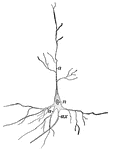
Nerve Cell
Nerve cell from the brain; a, processes by which it communicates with other cells near by;…

Border
A heavy border which shuts out a bleak field. In front of this border is an ideal place for flowers.

